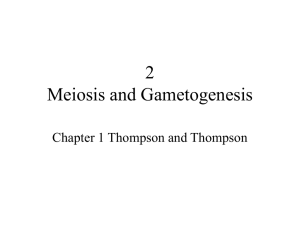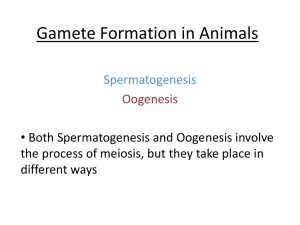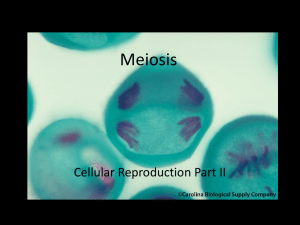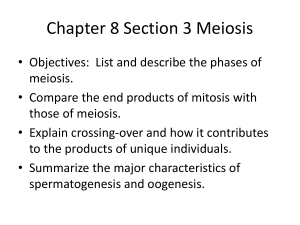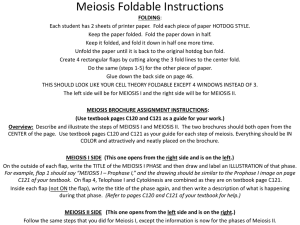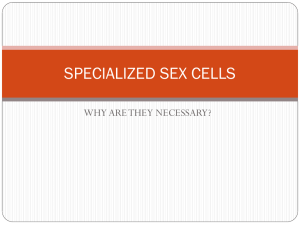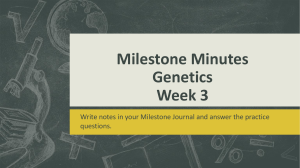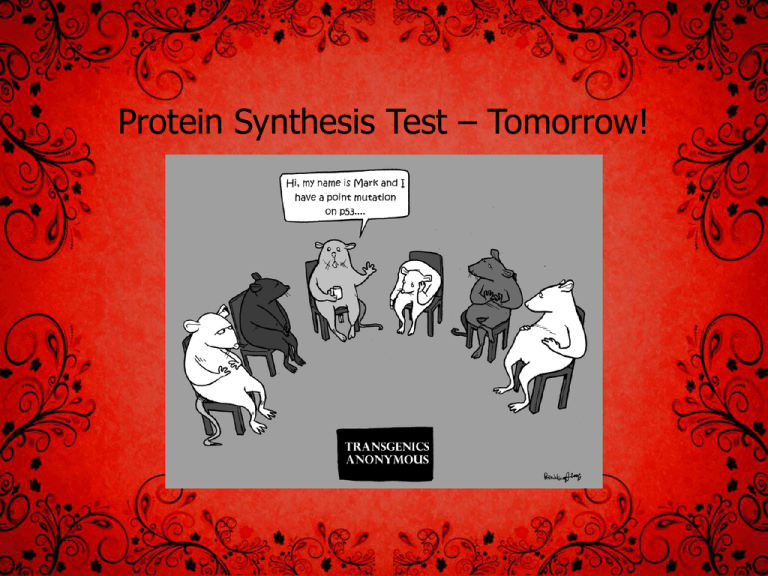
Protein Synthesis Test – Tomorrow!
Meiosis
Similarities and Differences between
Mitosis and Meiosis
Mitosis
Where does it occur
in body?
# Cell divisions
# DNA replications
Creates what type
of cell?
# Chromosomes in
End product
# Cells produced
Function
Meiosis
Mitosis Review
• IPMAT
• Remember:
Mitosis = Two Cells
“Tea for Two”
Reasons for Mitosis
• Production of 2 daughter cells that are
genetically identical
• Provides:
– a) a means of asexual reproduction for unicellular
organisms
– b) replacement of worn out and damaged cells
– c) growth of an organism
Zygote
Zygote
2n
2n
From Zygote to Embryo
Cleavage
Blastula
From Zygote to Embryo
Meiosis
• Special type of cell division that produces
haploid (n) sex cells (gametes)
• Meiosis is divided into 2 stages: Meiosis I and
Meiosis II
• Consists of 1 replication and 2 divisions
Formation of gametes
46
23
46
23
How many chromosomes will baby have?
Germ Cells
• Male
– Sperm producing machines
– Germ cells are found in the lining of the
seminiferous tubules (250m in each testicle)
– Once they reach maturity, they constantly divide
(Spermatogenesis)
• Female
– Germ cells - found in follicles in ovaries and
produced before birth
– Cells are suspended in Prophase I and don’t
continue to divide until puberty
– Complete their division after being simulated by
hormones during the menstrual cycle (Oogenesis)
Male
Female
Similarities and Differences between
Mitosis and Meiosis
Mitosis
Where does it occur
in body?
# Cell divisions
# DNA replications
Creates what type
of cell?
# Chromosomes in
End product
# Cells produced
Function
Meiosis
Let’s carry out an example for a
mosquito cell
Diploid Number (2n) = 6
Interphase I
• Period of growth of germ cells
• DNA replicates
Early Interphase I
Late Interphase I
Prophase I
• Nuclear envelope disappears
• Replicated chromatin coils into chromatid pairs
• Centrioles move to opposite poles of the cell
and start producing protein fibers that form
the spindle
Prophase I
• Synapsis
– Chromatid pairs attach to form tetrads
• Crossing over
– During synapsis, arms of chromatid pairs exchange
segments of DNA at chiasma
– Increases genetic diversity
Prophase I
Early Prophase I
Late Prophase I
Meiosis I – Metaphase I
• Tetrads line up at the equator of spindles
Meiosis I – Anaphase I
• Tetrads separate in an event called
disjunction
• Chromatid pairs are pulled to poles of cell
• Cleavage furrow begins to form
Meiosis I – Telophase I
• Cleavage furrow formation is complete and
cytokinesis occurs
• Nuclear envelope reappears
Meiosis II – Prophase II
• Most cells skip Interphase II and proceed
right into Prophase II
• Meiosis II follows the stages of Mitosis
Meiosis II – Metaphase II
Meiosis II – Anaphase II
Meiosis II – Telophase II
Differences of Meiosis and Mitosis
• Synapsis
– Happens in Prophase I
– Tetrad formation
• Crossing over
– Happens in Prophase I
– Arms of chromatids in a
tetrad swap DNA
– Increases genetic diversity
• Disjunction
– Happens in Anaphase I
– Tetrads separate and
chromatid pairs are pulled
to opposite sides of the
cell
• Non-Disjunction
– Happens in Anaphase I
– A tetrad does not separate
and sex cells are formed
with abnormal
chromosome numbers
Meiosis Square Dance
Step by Step Meiosis Animation
Dry Lab
In which phases will these
terms be present?
•
•
•
•
•
Chromatin
Replicated Chromatin
Chromatid Pairs
Tetrads
Chromosomes
Draw the stages of Meiosis from
Metaphase I to Telophase II if nondisjunction were to occur

